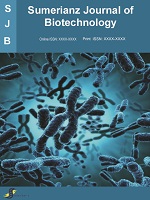Sumerianz Journal of Biotechnology

Online ISSN: 2617-3050
Print ISSN: 2617-3123
Quarterly Published (4 Issues Per Year)
Journal Website: https://www.sumerianz.com/?ic=journal-home&journal=32Archive
Volume 4 Issue 4 (2021)
Evaluation of Native Entomopathogenic Fungi Isolates for Microbial Control of the Mediterranean Fruit Fly (Ceratitis Capitata (Diptera: Tephritidae)) Pupae and Adults
Authors : Ayoub Hallouti ; Hinde Benjlil ; Abdellah El Hamdaoui ; Rachid Ait Hammou ; Mohamed Ait Hamza ; Abdelaziz Zahidi ; Abdellah Ait Ben Aoumar ; Hassan Boubaker
DOI : doi.org/10.47752/sjb.44.153.164
Abstract:Two isolates of the entomopathogenic fungi (EPF) Beauveria bassiana (Hypocreales: Cordycipitaceae), an isolate of Aspergillus flavus (Eurotiales: Trichocomaceae), of Verticillium sp. (Glomerellales: Plectosphaerellaceae) and of Aschersonia sp. (Hypocreales: Clavicipitaceae) were evaluated for their pathogenicity against the Mediterranean fruit fly Ceratitis capitata (Diptera: Tephritidae) pupae and adults under laboratory conditions, using four different concentrations. Pathogenicity towards pupae and adults was tested via spraying and body contact bioassays respectively. Average mortality of treated individuals ranged from 60 to 100% for pupae and from 39 to 100% for adults depending on the fungal isolates and concentrations. The highest mortality levels were observed for individuals treated by Verticillium sp., A. flavus and Aschersonia sp., while the B. bassiana isolates were the less effective against both adult and pupae. Estimated lethal concentrations 90 ranged from 3x105 to 3.8 x 107 conidia/ml for adults and from 6.58 x 103 to 2.5 x 105 conidia/ml for pupae with lower values calculated for A. flavus, Verticillium sp. and Aschersonia sp. Mean lethal times 90 were less than 79h for C. capitata adults and ranged from 94 to 273 hours for pupae according to the fungal isolates. Microscopic observation of treated pupae showed a mycelium growth on the bodies of death individuals, while visible signs of mycosis are less observed for adults. Results of these experiments demonstrated that native EPF isolates could be a promising biocontrol agent to manage safely C. capitata and might be used against pupae by soil application or against adults by cover or bait sprays.
Comparative Effect of Indole Acetic Acid and Salicylic Acid on Phytochemical Constituents and Antioxidant Potential of Three Genotypes of Tomato (Solanum lycopersicum (L.) Mill)
Authors : Olufolake O. Sowobi ; Adewale M. Esan ; Charles O. Olaiya
DOI : doi.org/10.47752/sjb.44.144.152
Abstract:Indole acetic acid (IAA) and salicylic acid (SA) are plant bioregulators that stimulate the desired growth and quality response in crops. This study examined the impacts of IAA or SA seed pre-treatment on phytochemical constituents and antioxidants potential in three genotypes of tomato plant. The results indicated that IAA and or SA treatments increased height of the three genotypes of tomato significantly (P ≤ 0.05) when compared with the control group. Lycopene, total flavonoid and phenolic contents of genotypes F2 cobra and panther 17 F1 treated with 40, 80, and 120 mg/L concentrations of IAA, respectively increased significantly as compared to the control group. Furthermore, IAA and or SA significantly increased H2O2 scavenging activity of F1 KIARA by 5.0% compared to the control (0.2%). Genotype F1 KIARA treated with IAA and or SA (80 and 120 mg/L) had a significant increase in DPPH scavenging activity by 55.0% and 53.0% respectively, relative to control group (11%). The Fe2+-chelating activity of IAA-treated (80 mg/L) F1 KIARA and F2 COBRA increased by 56.0% and 17.0%, respectively compared to the control. The synergistic effect of IAA and SA showed a significant effect on phytochemical constituents and antioxidant potential than individual treatment. The results showed that IAA application or in combination with SA could be used as an alternative bio-stimulant to improve the quality of tomato.
Clinico-Epidemiological Studies of Plasmodium Falciparum and Salmonella Typhi Co-Infection among Patients Attending Selected General Hospital in Northern Nigeria
Authors : Umar Mustapha ; Usman Jamila ; Iliyasu Rabilu Yandoma ; Mansur Sulaiman Aliyu ; Danjuma Faiza Muhammad ; Sagir Rabiu Muhammad ; Jakheng Shango P. E. ; Ajiya Garba Kilgori
DOI : doi.org/10.47752/sjb.44.133.143
Abstract:Study on the prevalence of co-infection between Plasmodium falciparum and Salmonella typhi among patients in Northern Nigeria was carried out. The study is cross-sectional designed to determine the socio-demographic characteristics as well as the risk factors for malaria and typhoid. A total of 100 consented patients of age group of 21-40 years were recruited for the study. A structured questionnaire was administered, and venous blood samples were collected and analyzed using standard microbiological methods. The isolated salmonella species were biochemically characterized, and subjected to antimicrobial susceptibility test using Kirby-Bauer disc diffusion method. The prevalence of malaria and typhoid was found to be 56% and 68% respectively. The prevalence of malarial parasite and Salmonella typhi infections was 40%. Females recorded low malarial infection of 56.9% compared to their male counterparts 43.1% (P= 0.510). The age group, educational levels and occupations of the study participants were not associated with the likelihood of having malarial parasite infection (P= 0.297, 0.15 and 0.503 respectively). Participants who did not sleep under the insecticide treated nets were more likely to have malaria than those who did (P ≤ 0.0001). The educational levels of the study participants were statistically associated with Salmonella typhi infection (P= 0.026). Water sources, use of pit latrine, hand washing before and after meal were significantly associated with Salmonella typhi infections (P= <0.0001 and P= 0.003 respectively). The isolates of Salmonella typhi and Salmonella paratyphi were found to be sensitive to chloramphenicol (86.8%), ciprofloxacin (80.9%) and amoxicillin (79.4%), but relatively resistant to penicillin and augmentin that recorded sensitivities of 19.1% and 35.3% respectively. The prevalence of malaria and typhoid infections as well as malarial parasite and Salmonella typhi co-infections is high among the study population. Fortunately, the isolated bacteria are highly sensitive to chloramphenicol and ciprofloxacin.


